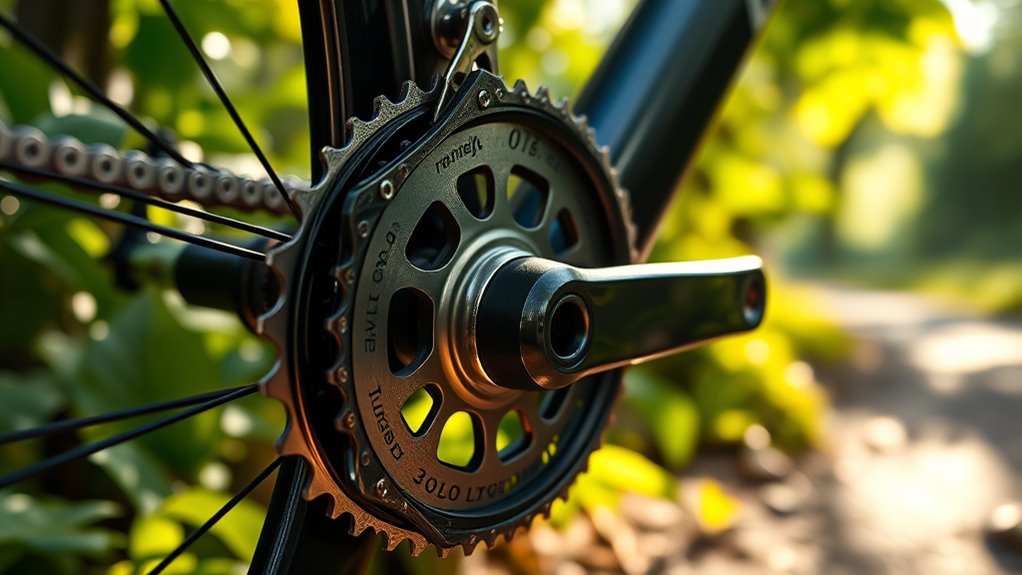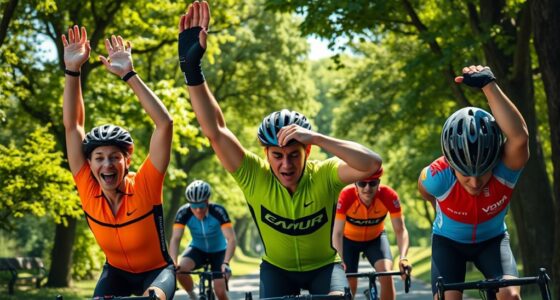To find your ideal cadence, aim for a steady RPM between 80 and 100, which balances muscle effort and efficiency. Pay attention to how your muscles feel, breathing, and overall comfort while you ride at different speeds. Your best cadence feels natural and sustainable over time, helping you pedal smoothly without excessive fatigue. Keep experimenting within this range, and discover the perfect rhythm that boosts your energy and performance—more tips are just ahead.
Key Takeaways
- Aim for a cadence between 80-100 RPM to balance muscle engagement and endurance efficiently.
- Use a cadence sensor or bike computer to monitor and track your RPM during rides.
- Experiment with different cadences to identify which feels most natural and sustainable over time.
- Maintain proper technique with relaxed upper body and smooth pedal strokes at your optimal RPM.
- Consistent training at your ideal cadence enhances overall cycling performance and reduces fatigue.

Have you ever wondered how to find the perfect pedal cadence to maximize your cycling efficiency? The key lies in understanding how cadence influences pedal efficiency and muscle engagement. Your cadence, measured in revolutions per minute (RPM), directly affects how your muscles work during each ride. When you choose a cadence that’s too low, you tend to push harder with each pedal stroke, resulting in increased muscle fatigue and less efficient energy use. Conversely, spinning at too high a RPM can lead to rapid fatigue in smaller muscles and a loss of control. The trick is to find a balance that enhances your muscle engagement while maintaining pedal efficiency.
Finding the ideal cadence balances muscle engagement and pedal efficiency for optimal cycling performance.
To start, pay attention to how your body feels at different cadences. Many cyclists find that a moderate, steady RPM—usually between 80 and 100—is a good baseline. At this range, your muscles can sustain effort without overexertion, and your pedal stroke remains smooth. Maintaining a consistent cadence allows you to engage muscles more effectively, reducing wasted energy and preventing unnecessary fatigue. When you focus on pedal efficiency, you’re fundamentally training your muscles to work in harmony, producing maximum power with minimum effort.
Another important aspect is to consider your muscle engagement. When you pedal at an ideal cadence, you activate the right muscle groups—primarily your quadriceps, hamstrings, glutes, and calves—in a balanced manner. This balanced engagement prevents over-reliance on any one group, which can lead to fatigue and even injury over time. To improve muscle engagement, try to maintain a relaxed upper body and focus on a smooth, circular pedal stroke. This technique encourages continuous muscle engagement rather than jerky, inefficient pushes. Incorporating proper cycling technique can further enhance your efficiency and prevent strain.
Experimenting with different cadences during your rides can be eye-opening. Use a cadence sensor or a bike computer to track your RPM and note how your muscles respond. Do you feel more energized riding at 85 RPM, or do you perform better at 95 RPM? Pay close attention to your breathing, muscle fatigue, and overall comfort. Over time, you’ll begin to notice which cadence feels most natural and sustainable for your body. Remember, the goal isn’t necessarily to spin as fast as possible but to find that sweet spot where pedal efficiency and muscle engagement align to give you maximum performance with minimal strain. Consistently practicing at your ideal cadence will help you ride longer, stronger, and more comfortably.
Frequently Asked Questions
How Does Terrain Affect My Optimal Cadence?
Terrain adaptation profoundly impacts your ideal cadence. When you face uphill climbs, you should shift to lower gears to maintain a steady cadence, preventing fatigue. On flat or downhill terrain, you can increase your RPM comfortably by selecting higher gears. Adjusting your gear selection based on terrain helps you keep a consistent cadence, improve efficiency, and reduce strain, making your ride smoother and more enjoyable regardless of the landscape.
Can Cadence Improve My Overall Cycling Endurance?
Think of your pedaling rhythm as the steady heartbeat of your ride. Yes, maintaining cadence consistency can boost your endurance by training your muscles and cardiovascular system to work efficiently. When you focus on a smooth, rhythmic cadence, you conserve energy and delay fatigue. Over time, this sustained pedaling rhythm strengthens your stamina, allowing you to ride longer distances with less effort and greater confidence.
What Gear Ratios Best Support Different Cadences?
Choosing the right gear ratios depends on your cadence zone training goals. For high cadences, opt for smaller chainrings and larger sprockets to keep effort manageable. For lower cadences, use larger chainrings and smaller sprockets to generate more power. Adjust gear ratio selection based on your desired cadence zone, ensuring smooth shifts and efficient pedaling. This approach helps optimize your performance across various terrains and training intensities.
How Do I Measure My Current Cadence Accurately?
Imagine your cycling world hinges on every tiny pedal stroke—so measuring your cadence accurately is essential! Use cadence sensors attached to your crank or wheel to get real-time data, ensuring precision. Focus on your pedal stroke, counting revolutions per minute. Keep the sensor calibrated and wear it consistently. With these tools, you’ll reveal your perfect RPM, transforming your ride into an effortless, exhilarating experience!
Does Optimal Cadence Vary Between Beginner and Advanced Cyclists?
Yes, your ideal cadence varies between beginner and advanced cyclists. Beginners often have a lower cycling cadence due to less developed cadence biomechanics, making higher RPMs feel uncomfortable or inefficient. As you gain experience, your cadence biomechanics improve, allowing you to maintain a higher cycling cadence comfortably. Understanding cycling cadence history helps you recognize that optimal RPM adapts with skill level, ensuring you ride efficiently and reduce fatigue as you progress.
Conclusion
Remember, finding your best RPM is all about tuning into your body and riding your own race. Don’t be afraid to experiment and adjust until you find that sweet spot. It’s not about keeping up with others but about working smarter, not harder. When you strike that balance, you’ll see improvements without burning out. Keep at it, and soon you’ll be cruising at a cadence that feels just right—proving that practice makes perfect.









